What is an FPV Drone? Everything You Need to Know
![]()
It’s incredibly satisfying to capture awe-inspiring aerial shots with a drone, and while seeing the world from high above is always intriguing, some pilots make an exciting flight as big of a part of the experience as the beautiful scenery that’s being highlighted.
That said, it isn’t exactly easy to achieve these acrobatic moves. Any camera drone allows you to change your perspective and get shots that would be difficult or impossible any other way. That means an FPV drone might not be the right choice for you, depending on the type of video or photo you want to capture.
Table of Contents
What Does FPV Mean?
In the drone world, FPV stands for “first-person view” and it means that, as the pilot, you can see what the drone sees. It suddenly makes you more mobile than ever before and lets you see things that could have been missed from the ground, like flying over the treetops or under bridges. Most modern drones include a camera and the ability to transmit a live feed to a smartphone. Technically, nearly every drone is an FPV drone but that definition is changing.
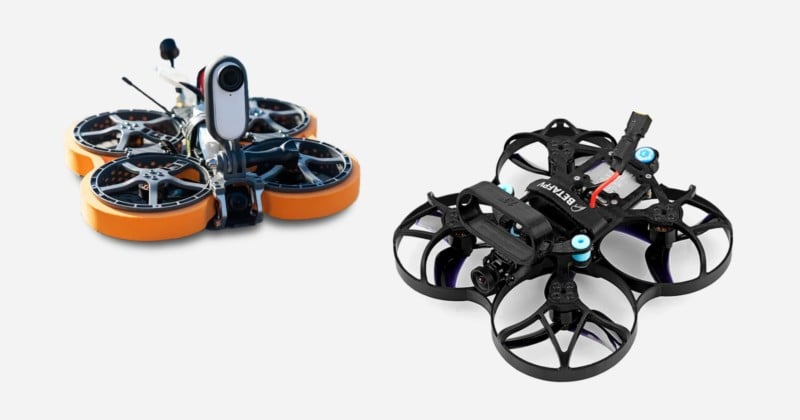
To the leading drone manufacturer in the world, FPV means something more. While every DJI drone can provide a first-person perspective from the camera, only two of its drones come with a head-mounted display for totally immersive viewing. The DJI FPV and DJI Avata include a complete FPV system with a preassembled drone, battery, camera, transmitter, remote controller, and goggles.
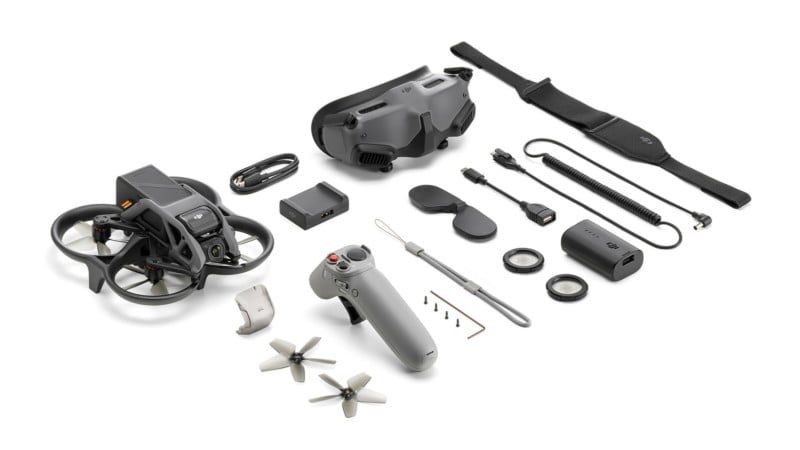
This, in itself, is unique in the world of FPV racing drones, which are sometimes sold as a collection of parts, sourced from various manufacturers. This gives you the ability to customize but could result in compatibility issues. Other manufacturers sell bundles or ready-to-fly drones such as DJI’s FPV and Avata, which are more inviting alternatives for most people.
DJI Avata Versus DJI Mini 3 Pro
The DJI Avata and the DJI Mini 3 Pro are great examples of DJI’s latest drones and a convenient way to compare a standard drone to an FPV drone that uses a head-mounted display. The Avata is DJI’s newest FPV drone featuring head-mounted Goggles 2 and a Motion Controller, while the Mini 3 Pro has a classic joystick-based controller with a holder to insert your iPhone or Android phone to serve as the display. Each uses the latest DJI technology for stable flight (even in moderate wind), solid tracking, reliable signal transmission, and a high-quality camera for great photos and videos.
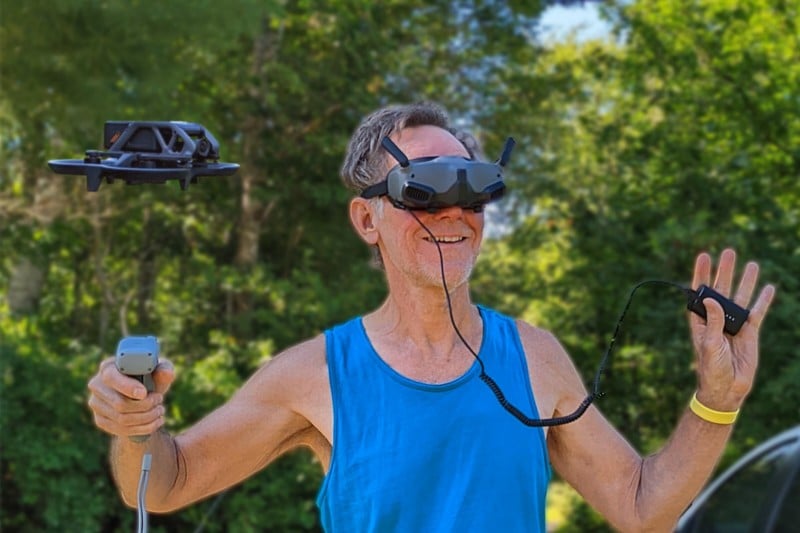
There are enough similarities between these two drones that the differences stand out clearly. Strapping a headset on means there won’t be any problem with seeing the screen in bright sunlight and the Avata’s Goggles 2 are surprisingly comfortable. Diopter adjustments allow tuning the sharpness to your particular vision, eye spacing controls for interpupillary distance keep your view of the screen crisp, and the microLED display ensures a bright and vivid preview of what will be recorded.
The downside to wearing goggles is that your natural vision is obscured entirely. That means you’re legally required (in the United States) to have someone else who can act as a spotter to keep an eye out for hazards that might not be visible while you’re piloting the Avata, so an FPV drone might not be a good choice if you plan on flying solo. With the Mini 3 Pro, it’s a different experience. When using a phone as the display, it’s easy to glance up and see the drone and nearby objects with your own eyes, then look back to the smartphone to continue watching the view from above.
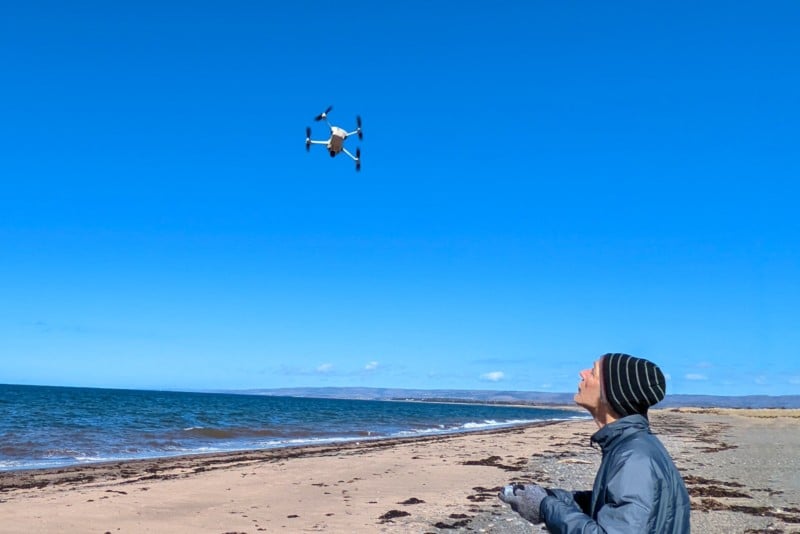
Speaking of regulatory ease, the Mini 3 Pro is under 249 grams and doesn’t need to be registered before use, although every drone pilot must pass a test. Even though the DJI Avata is smaller, it weighs more at 410 grams so it must be registered. Registering a drone costs just $5 and it can be done online in a few minutes, so it really isn’t a big deal.
The FAA’s TRUST test is designed for recreational pilots. TRUST is a short and simple test made up of multiple-choice questions. If you’re flying a drone for commercial purposes, registration and a more challenging test are required, regardless of its weight. The full details are available on the FAA’s website and are subject to change, so it’s worth taking another look from time to time. The TRUST test is a relatively new rule that took effect in the summer of 2021.
How Do You Fly an FPV Drone?
Most FPV drones use a familiar-looking remote control that’s quite similar to a game controller. Two joysticks allow control of throttle, yaw, roll, and pitch. These controls give you complete freedom of movement but require many hours of practice to master. The throttle increases the speed of the propellers and lifts the aircraft. At least some throttle must be maintained to keep the drone in the air. Adjusting the yaw control spins the drone around its vertical axis. Pitch angles forward and backward while roll tilts left and right. With a combination of these controls, any kind of flying is possible from lazy loops around a park to advanced tricks like barrel rolls and back flips.
DJI changed the game with its FPV drones because they have the option to reassign the joysticks to control the heading, height, and position of the drone in a horizontal plane, allowing you to think about flying in more traditional terms. That means it’s a bit like driving a car with the added ability to raise and lower the drone whenever you’d like. If you release the controls, the drone simply hovers in place until you’re ready to fly again.
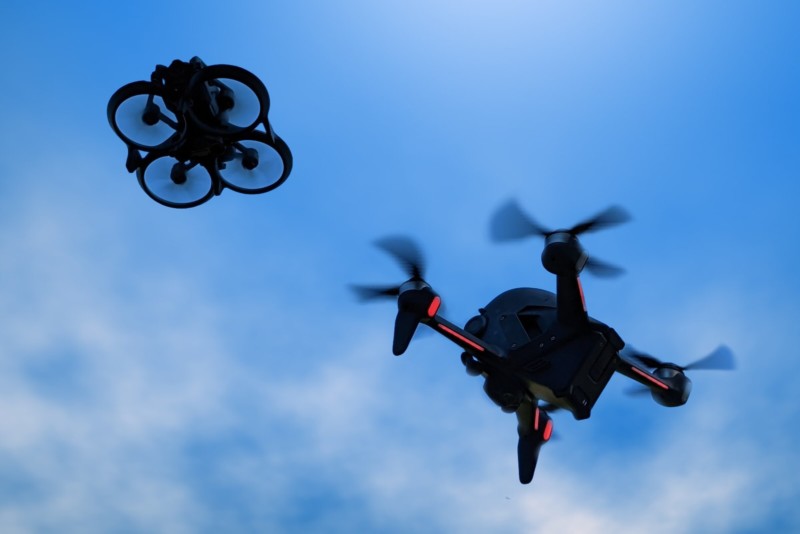
The great thing about the DJI FPV and Avata is that their incredible speed and maneuverability are still available, albeit at lower top speeds, in these easy-to-fly modes. There’s room to grow as a pilot and assume full manual control when you’re ready to pilot a drone without DJI’s robust flight assistance software.
Besides assisted flight and manual control, DJI offers a third option for the Avata and FPV drone that’s unique, the Motion Controller. Shaped like an infrared temperature gun, this advanced remote control detects your hand movements, rotating the drone and tilting the camera accordingly. It’s surprisingly intuitive since DJI shows a white circle in the goggles display that indicates the direction that the drone will fly when the trigger is squeezed.
Why You Should (and Shouldn’t) Get an FPV Drone
The great thing about an FPV drone that has goggles is the immersive sense of flight. It’s about the closest you can come to the experience of soaring above the treetops at high speed with few limitations, relatively safely, and at an affordable price. A small FPV drone with goggles and intuitive controls, like the DJI Avata, might make it easier to pilot through small spaces in calm conditions.
That said, some FPV drones are difficult to master. Being fully in the moment, while enjoying soaring like a bird, only comes after many hours of practice. The initial experience will more likely be filled with frustration, delays, and unexpected expenses as trial and error take a toll on components, leading to ongoing maintenance costs.
FPV drones, even those from DJI, ship with cameras that can’t compete with the best drones on the market. Many FPV drones come without a camera or ship with a 1080p camera. The Avata and DJI FPV have 4K resolution but narrower apertures and smaller sensors than the Mini 3 Pro, for example. Special features like RAW mode photography and hyperlapse video are uncommon in an FPV drone.
Another downside with FPV drones is the added cost of the goggles. The DJI FPV is $999 and the Avata is $1,388. The price is understandable, given the amount of technology packed into these systems but it’s much higher than other DJI drones with better cameras. A pilot of a small FPV drone can navigate tight spaces with relative ease as seen in this YouTube video by AvataTime of a trip through a forest of dappled light.
Other FPV drone manufacturers usually sell kits and when the specifications are brought up to the level of DJI’s drones, the price might be even higher. If you’re willing to get deep into the builder world, bargains can be found and costs can be minimized by getting exactly as much power, flexibility, and camera quality as needed, and no more. It takes time and effort to delve into the details and learn enough to build a nice drone.
The excellent DJI Mini 3 Pro, by contrast, costs $759 and its camera outperforms those of DJI’s FPV drones. If high-fidelity video and photos are the goals, it’s hard to beat at this low price. The tradeoff is a lower maximum speed, no option for manual mode, a less immersive experience since DJI’s goggles aren’t supported, and there’s no option to use the Motion Controller. There are third-party solutions that allow using a VR headset but they aren’t really comparable to the experience of piloting the DJI Avata or FPV. This YouTube video from Drone The Sky shows how to use a DJI Mini with a VR headset and the Litchi app.
The DJI FPV can blast by at 87mph in manual mode and the Avata can reach 60mph when flown with an FPV Remote Controller 2 in Manual mode. Both are much faster than a regular drone, however, but are slower in the Sport and Normal modes that are much easier to pilot. For most people, flying in normal mode can feel fast if space is limited. The Avata can reach 17mph in Normal and 31mph in Sport mode, while the FPV holds the DJI crown, even with assisted flight features enabled, at 34mph in Normal and 60mph in Sport mode.
As a demonstration of the FPV’s incredible speed in manual mode, DJI posted a video of a race against a sports car. If you have plenty of open space or intend to fly above obstacles, the DJI FPV can take you further than most other drones in this price range.
The Mini 3 Pro is no slouch and clocks in at 22mph in Normal mode and 36mph in Sport mode, outpacing the Avata when using DJI’s flight assist features. That means speed isn’t always a deciding factor when choosing between an FPV drone and one optimized for photography.
Is an FPV Drone Right for You?
You might still be wondering if an FPV drone is right for you and, if so, which one. As with most technology, the answer depends on what you want and what you need to capture. Are aerial photography and video most important or do you want a faster and more agile camera drone?
DJI’s standard drones, like the Mini 3 Pro, have many more features that are geared toward recording cinematic video and special camera modes. You can take RAW photos, stitch together panoramas, shoot hyperlapse videos, and use pre-programmed flight moves such as MasterShots and QuickShots. It’s easy to automate the maneuvers needed to record impressive aerial videos with a Mini 3 Pro, and if that’s what you’re looking for, it’s hard to go wrong with a DJI Mini 3 Pro. A unique feature of the Mini 3 Pro is the ability to physically rotate its camera and record videos in portrait orientation.
The DJI FPV is among the fastest drones on the market and DJI’s fastest. It isn’t legal to fly an FPV drone faster than 100mph, so DJI’s thrilling, 87mph FPV drone gets pretty close to that hard limit. The FPV also costs less than the Avata, but it’s an older system. The DJI FPV’s 1/2.3-inch camera sensor and 720p Goggles V2 fall behind the Avata’s 1/1.7-inch sensor and its 1080p Goggles 2. It’s important to note the lack of a ‘V’ in the name of the new headset because the Avata is also available with the older Goggles V2 for $220 less. When choosing the small and light Avata, it’s more natural to opt for the improved, smaller, lighter, Goggles 2 in the Pro View Combo. The DJI Avata has a couple of additional tricks up its sleeve.
The Avata’s head-tracking option lets you synchronize the rotation of the drone and tilt of the camera with your head movement. That makes it possible to fly in one direction and look in another, which isn’t currently possible with the DJI FPV when paired with the Motion Controller. Flying sideways while shooting video is still easier with a joystick controller but it is possible with the Avata’s head-tracking. Just make sure you have a spotter when moving in a different direction than you’re seeing in the headset. Check out the sort of video possible with head-tracking.
Have you ever wondered what it would be like to be a dragonfly? DJI gave the Avata the ability to fly very close to the ground and skimming over a forest stream and moss-covered stones with just 10 inches of clearance produces unique video that’s unexpected from an FPV drone.
Conclusion
An FPV drone might not be the right choice for you, even if you want to fly fast. The feeling of flying a drone isn’t like driving a car on a highway where roads are designed to be straight or to bend in gentle curves. Drones can reach their top speed in seconds and can make hairpin turns, all while flying close to the ground and maneuvering through tight spaces. Your sense of speed is greatly amplified in these cases and reaction time dwindles to microseconds.
DJI’s Mini 3 Pro is an excellent choice for getting started with aerial photography. The DJI Avata is a nice middle ground and can probably go as far and as fast as you would ever need. If you prefer to push the limits, the DJI FPV or a full manual FPV drone kit might be the right choice to test your reflexes and your piloting skills.